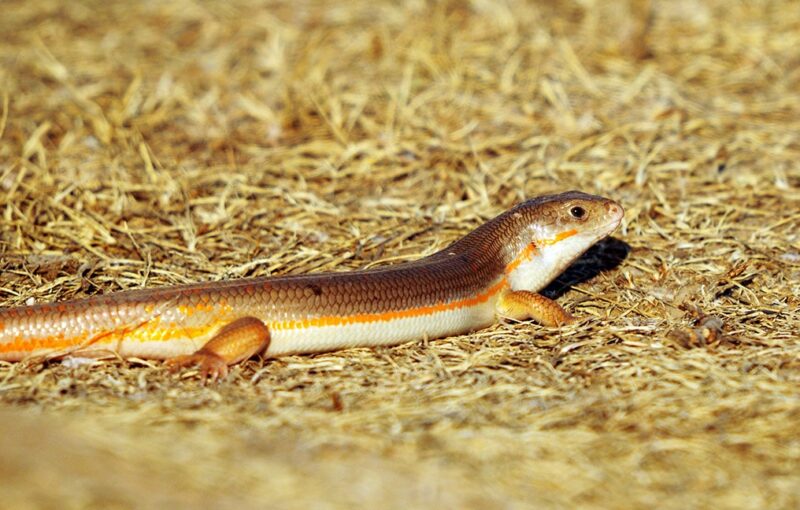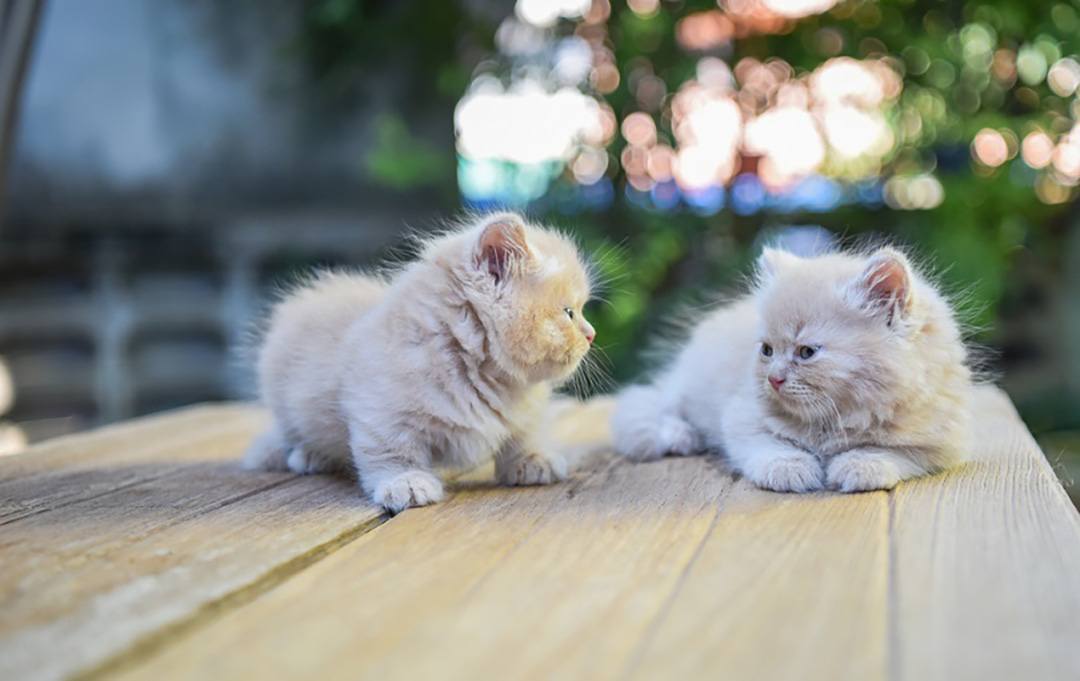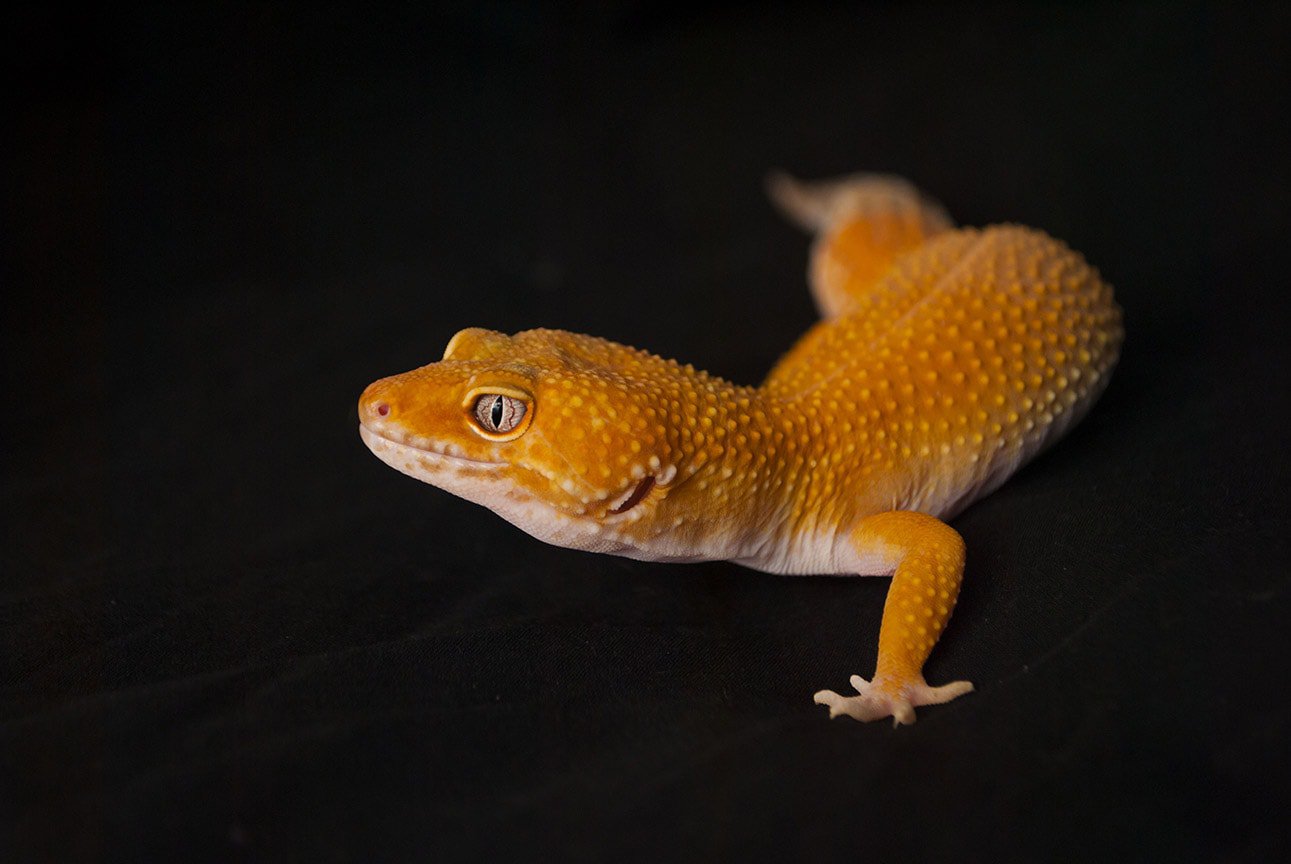Click to Skip Ahead
Lizards can be wonderful and interesting pets, and there are several species to choose from, including the Schneider’s skink.
The Schneider’s skink, also known as the Berber skink and the dotted skink, can live to be up to 20 years old, and owning one is a big commitment. Read on to see if the Schneider’s skink would be a good fit for you and your family.

Quick Facts About the Schneider’s Skink
| Species Name: | Eumeces schneiderii |
| Family: | Scincidae |
| Care Level: | Beginner |
| Temperature: | Basking spot, 95° to 100°F, Cool end, 70° F |
| Temperament: | Friendly and full of personality |
| Color Form: | White underbelly with olive-brown back |
| Lifespan: | 15 to 20 years |
| Size: | 12 to 16 inches |
| Diet: | Omnivore |
| Minimum Tank Size: | 30” long by 12” deep by 12” high |
| Tank Set-Up: | Terrarium |
| Compatibility: | Gets along well with others of the same species |

Schneider’s Skink Overview
Schneider’s Skinks are named after the German zoologist Johann Gottlob Theaenus Schneider. They originate from North Africa and the Middle East. They are a species of lizard in the family Scincidae. There are five subspecies of Schneider’s Skinks.
The Schneider’s Skink is a medium-sized lizard with a white underbelly and an olive-brown back with orange specks throughout. They are a low-maintenance pet because they have a mellow personality and are hardy. They are also lovely to look at. They enjoy spending time in your hand and will even crawl up to your head if they can. They tend to be active and inquisitive little creatures.
They like their habitat hot and dry, similar to how you would house a Bearded Dragon. They also need plenty of places to hide and burrow, and keeping a proper setup for them will help keep them happy and healthy.
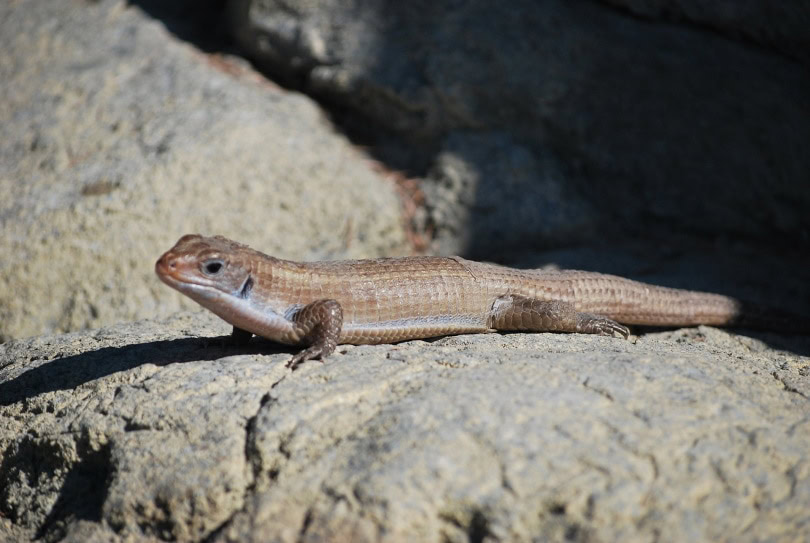
How Much Do Schneider’s Skinks Cost?
Most Schneider’s Skinks in pet stores and online are captured from the wild because it is hard to breed them. They are often caught in the semi-desert areas of Egypt.
Typically, a Schneider’s Skink costs between $25 and $60, but be aware that if you purchase one online, there will most likely be a hefty overnight shipping fee of around $50.
Typical Behavior & Temperament
Schneider’s Skinks are active and curious creatures. They will explore new areas if given the chance. They also enjoy being held and will climb all over you, but they also love running around their enclosures. They may be small, but they have a lot of energy!
Appearance
The Schneider’s Skink can grow up to 12 to 16 inches. They have a snub snout, small, sturdy limbs, and a tube-shaped body. Their underbelly is white, and the top of their body is olive-brown with specks of orange.

How to Take Care of the Schneider’s Skink
Habitat, Tank Conditions & Setup
Enclosure
You should have at least a 3-foot vivarium when housing one skink. If you plan to have more than one, having more room is a good idea so they can avoid each other if they need time alone. The skinks should have at least 2–3 inches of substrate to burrow in.
There should also be hiding places and basking perches; using a cork bark tube or artificial cave will work well. Adding flexi sticks and vines also provides extra climbing space for your skinks. Be sure to keep the vines and sticks close to the floor, though, as Schneider’s Skinks are not good climbers and could fall from a higher location.
A water bowl should also be provided for the skink to drink and bathe in. Provide one that is large enough for the skink to fit in but small enough to escape easily. Avoid a tragedy by ensuring the bowl is not too big or has steep walls.
Lighting
Schneider’s Skinks are diurnal; they are active during the day and inactive at night. You should adjust their lighting to accommodate this. Schneider’s Skinks require UVB, so a UVB lightbulb is necessary. This light should be on a timer and shut off every 12–14 hours. Be careful of letting natural light shine on the enclosure in addition to the bulb, as it can cause the temperature to rise to unsafe levels.
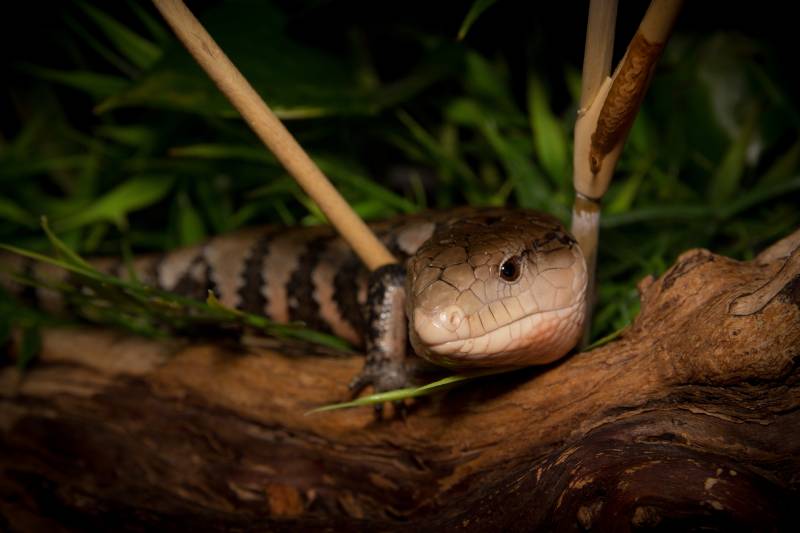
Temperature
Each enclosure should have a warm side and a cool side. The cool side should be around 75 to 82 degrees Fahrenheit, and the hotter side should be 90 to 105 degrees Fahrenheit. Invest in thermometers for both sides of your enclosure so you can closely monitor the temperatures in the tank.
Humidity
Schneider’s Skinks prefer dry conditions, and the humidity in the habitat should not exceed 40%. You can achieve this by misting only once daily in the morning. During shedding time, you should mist twice a day to help the skink with their shedding process. You can tell if your skink is about to shed if their skin looks dry and faded.

Do Schneider’s Skinks Get Along With Other Pets?
Schneider’s Skinks get along well with others of their own species and can be housed with one or two other Schneider’s Skinks. They are social creatures and enjoy having the company of other skinks.
Be sure to keep them separate from cats or dogs. Larger animals can hurt the smaller skinks, and cats have a prey drive that makes them more likely to chase and hurt smaller animals.
What to Feed Your Schneider’s Skink
The main part of a skink’s diet should consist of mealworms and live crickets. They should also be fed fruit and vegetables once a week to stay healthy. Bananas, apples, carrots, and grapes are all great to try out. Some skinks may be picky, so you may have to try various foods before finding some your skink enjoys.
You can try feeding your skink a boiled egg, but you must cut it into small pieces. They also can eat thawed frozen pinkie mice in moderation.
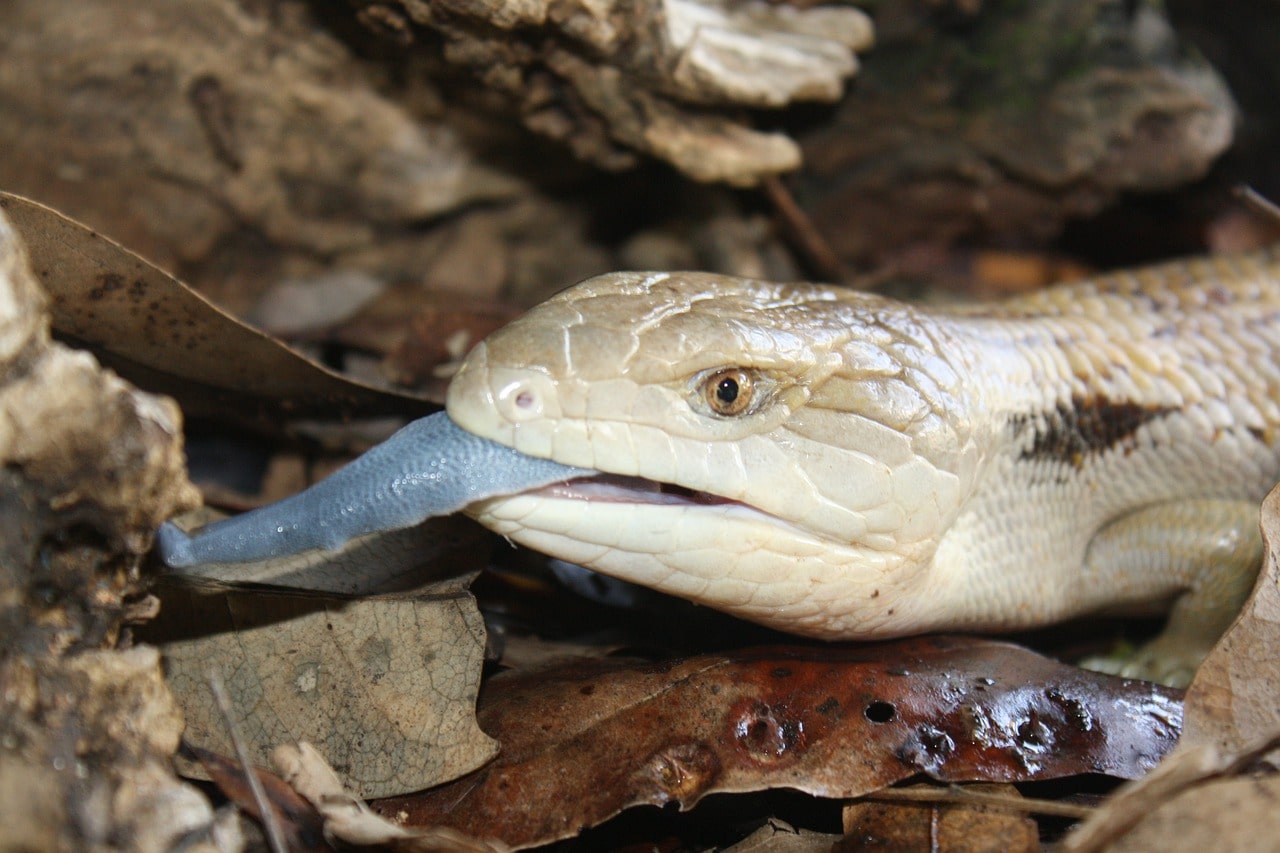
Keeping Your Schneider’s Skink Healthy
A healthy Schneider’s Skink will be active and alert. Signs of loose skin on your skink could point to an underlying illness. Other signs to look out for include diarrhea, fluid or mucus from the nose, or swollen hind limbs.
To keep your Schneider’s Skink healthy, you should provide them with proper housing, feed them an appropriate diet, and interact with them regularly to watch out for signs of illness. Providing the right amount of light and humidity in their setup is also vital.
Schneider’s Skinks are hardy animals, so if you follow the care guidelines for skinks, you should see few health problems.
Breeding
Breeding Schneider’s Skinks can present a difficult challenge, as they are not prone to mating in captivity, hence why most skinks are captured in the wild.
Their mating behavior is quite aggressive, and females can often be injured as a result. Fertilized eggs are then carried for 6 to 7 weeks. After that, you should incubate the eggs for an additional 7 to 10 weeks.
Schneider’s skinks are also monoestrous, meaning they only have one clutch of eggs every year. This makes breeding even more difficult, as there is only one chance per year to breed them.


Are Schneider’s Skinks Suitable for You?
Schneider’s Skinks are fascinating lizards that enjoy interacting with humans. Due to their hardy nature, they are a great first pet if you have never owned one. They are ideal if you want a lizard that will let you handle them frequently. They are also entertaining to observe, especially when they run around or hunt. If you can construct a suitable habitat, have the time to devote to them, and understand that they could be a 20-year commitment, a Schneider’s Skink could be the perfect pet for you!
Featured Image Credit: Durzan Cirano, Shutterstock
